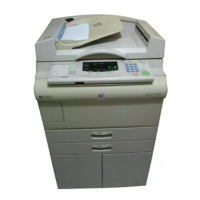Table 6. ID correction
Step Development Bias Correction for the V
SP
Pattern
Initial 0 V
1st –40 V
2nd –80 V
If no correction is applied, the charge on the drum for the V
SP
pattern is
–600 V, and the development bias for the V
SP
pattern is –300 V. So there is
a difference of 300 V between the development roller and the drum for the
V
SP
pattern.
When the ID correction is applied, the voltage difference is reduced. For
example, if a –40 V ID correction is applied, the difference in voltage is:
Before ID Correction: –300 – (–600) = 300 V
After ID Correction: –300
– 40
– (–600) = 260 V
As a result, the effect of the change in chargeability of the carrier particles is
canceled. The darkness of the V
SP
pattern returns to normal.
1.3.4 Toner Supply Control During Copying
There are three modes for controlling the toner supply.
• Detect supply mode
• Fixed supply mode
• TD sensor supply mode
The mode can be selected with SP2-208-001. The factory setting is detect
supply mode.
Toner clutch on time is calculated by the following formula.
Toner CL on time [ms] =
S x AT x TSC
⁄
100
TS
(Formula 1)
where: S = Copy paper size [cm
2
]
AT = Amount of toner developed on the latent image per unit area
= 0.7 [mg/cm
2
] (constant)
TSC = Toner supply coefficient [%]
TS = Amount of toner supplied per unit of time
= 0.183 [mg/ms] (for A153, A155, and A156 copiers)
= 0.133 [mg/ms] (for A157, A159, and A160 copiers)
AT and TS are constant, and S depends only on paper size, but TSC is
determined in different ways depending on which toner supply mode is in
use.
A156/A160/A162 2-14 STM

